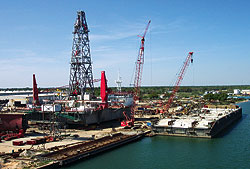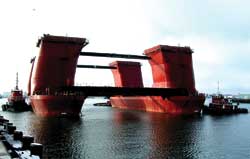Oil Industry Push Has Maine Contractor Looking Far Afield
 |
Now, as work on the oil exploration rigs nears successful completion, Cianbro Corp. and the City of Portland, whose economy gained a boost from the work, are looking for more maritime-related business opportunities.
Pittsfield-based Cianbro was competitively selected in spring 2002 by Petrodrill Engineering NV, Rotterdam, the project manager, to complete the two dynamically positioned, semisubmersible rigs. The project had been stalled for a year by the bankruptcy of contractor Friede Goldman Halter Inc., Gulfport, Miss. Cianbro declines to reveal project costs but published reports say the two rigs were valued at $340 million when FGH began work in 1999.
 |
| TALL TOWERS Pontoon assembly arrives in Portland Maine. |
The rigs are part of the Amethyst Project, a six-rig construction program Petrodrill started in 1998. Only two rigs have been finished. They were built in Korea and have been working in Brazil for two years, says Peter Hickson, Petrodrill deputy project director.
Two others were scrapped when the parent company of Canada's Davie Shipyard went into bankruptcy, according to Hickson. The last two rigs languished in a partially completed state at yards in Orange, Texas, and Pascagoula, Miss. When Cianbro picked up the job, each consisted of a deck box and derrick and two, four-column pontoon assemblies.
|
"In each case the 5,500-ton deck box and derrick were sitting on shore and the pontoons and columns were in the water," says Peter G. Vigue, Cianbro president. "We put the boxes on a 400-ft- long by 100-ft-wide barge and towed them individually to Portland along with the pontoons and columns. Then, we mated them in Maine."
It took 160 freight containers to pack and ship the remaining parts and pieces. Sorting, bar coding and storing the inventory took a month. The first pontoon segment arrived in Maine last April.
 |
The mating process, called a "floatover," involved submerging the 250-ft-long pontoons 60 ft and then maneuvering the barge between the columns so the deck box could be welded into place. The pontoons were then deballasted and the barge floated out. "The process took about 17 days for each rig," says Robert W. Blackmore, Cianbro manager of nuclear programs and special projects. "We believe this is a first for the U.S."
 |
The mating was done over the summer and fall of 2002. About 850 people are involved in the outfitting. Most are Cianbro employees. "The timing is good because the economy is soft so we're self-performing many functions," says Vigue.
Cianbro leased the Portland Ocean Terminal from the City of Portland for the work. The 12-acre site, formerly the repair facility for Bath Iron Works, includes two deep-water piers and a 135,000-sq-ft building complex. "Cianbro brought it up to code and adapted the site for their use," says Jeffrey W. Monroe, the city's director of ports and transportation. "We're hoping they will stay and do more maritime fabrication and major conversion work because it's been an economic boom to the area."
The 324-ft-high rigs tower over the Portland waterfront. When finished, each will weigh 12,000 tons. Each is equipped with 20 Mw of generating capacity and fitted with about 90,000 ft of pipe.
 |
Blackmore says the project is a good fit for Cianbro. "We were looking to export our skills and oil rigs were a perfect match," he says. "We do a lot of paper mills and powerplants, which involves pipe and electrical work. Outfitting and converting marine rigs, ships and barges can keep our employees working. With our work ethic we can be successful in these fields."
The job also took a surprising amount of rework, Blackmore says. "We had to disassemble and clean numerous pumps and valves to make sure they worked and we had to redo a number of bulkhead penetrations and piping runs." Also, equipment was already in place but interior bulkheads, ceilings and floors were unpainted. Working around the equipment was time-consuming and costly, he says, declining to provide details.
 |
| LATERAL MOVE Deck box in Pascagoula was jacked up, then hydraulically moved by rail onto a nearby barge. |
When completed later this year the rigs will go to work in warm offshore waters either in the Gulf of Mexico or somewhere between Africa and Brazil. The exploratory rigs are hired out to oil companies and can travel under their own power. They have eight variable pitch thrusters to keep them on GPS-established stations and can work in 5,400 ft of water, drilling down another 15,000 ft. When oil is found the drilling is capped with a wellhead. Production is handled by another rig.
The rigs are registered in the Bahamas as ships and incorporated in the British Virgin Islands.
(PHOTOS COURTESY OF CIANBRO)
